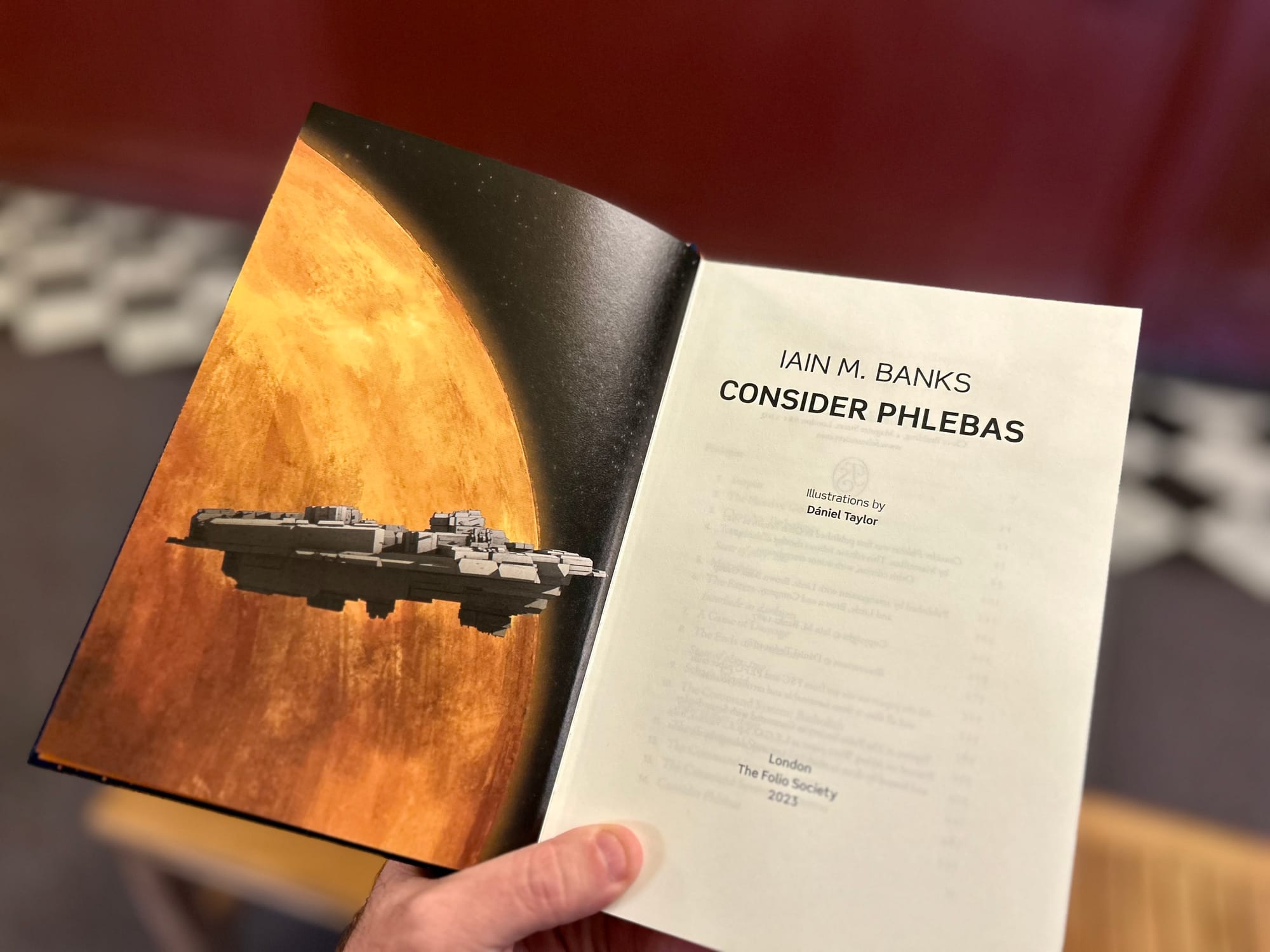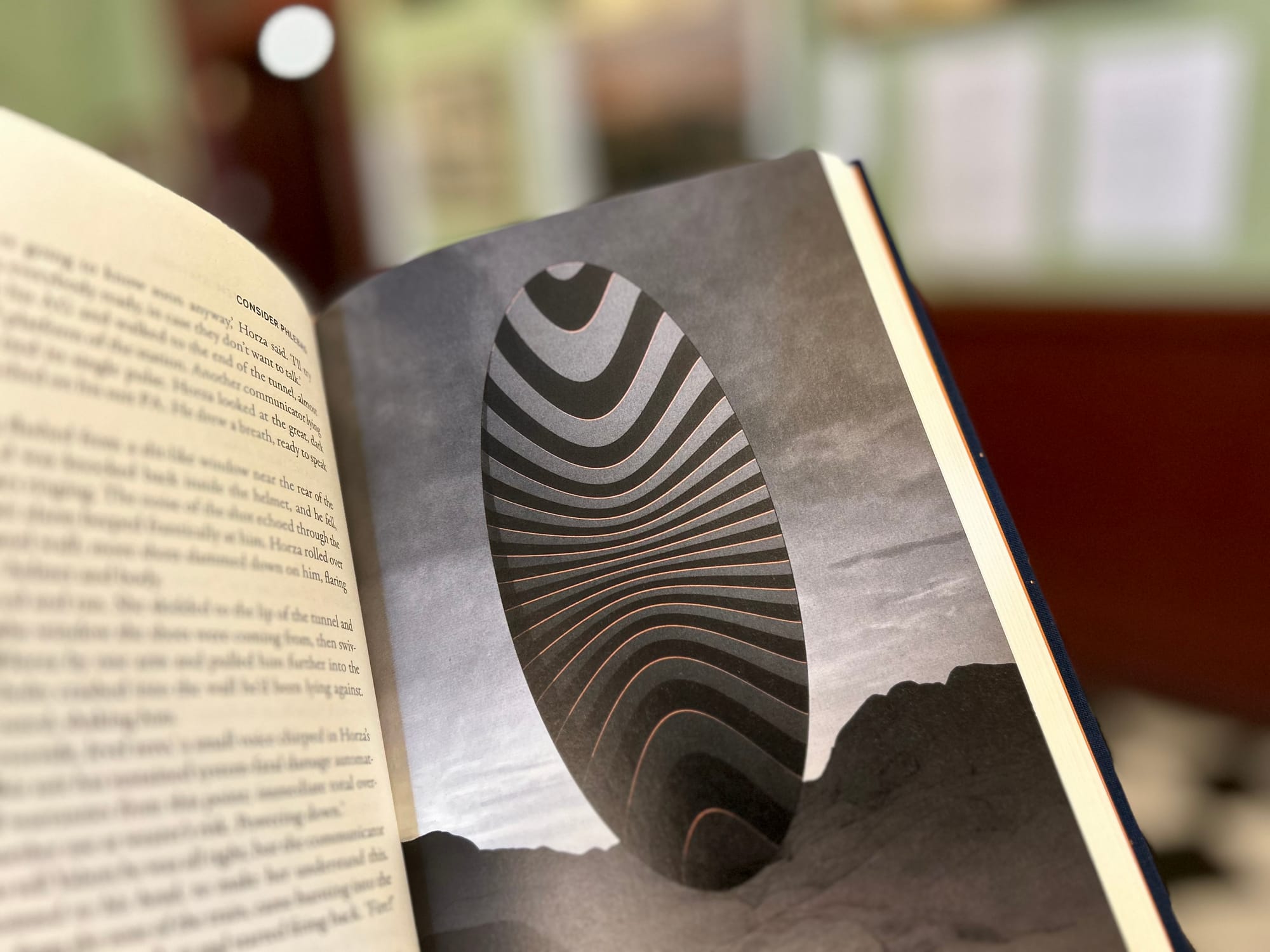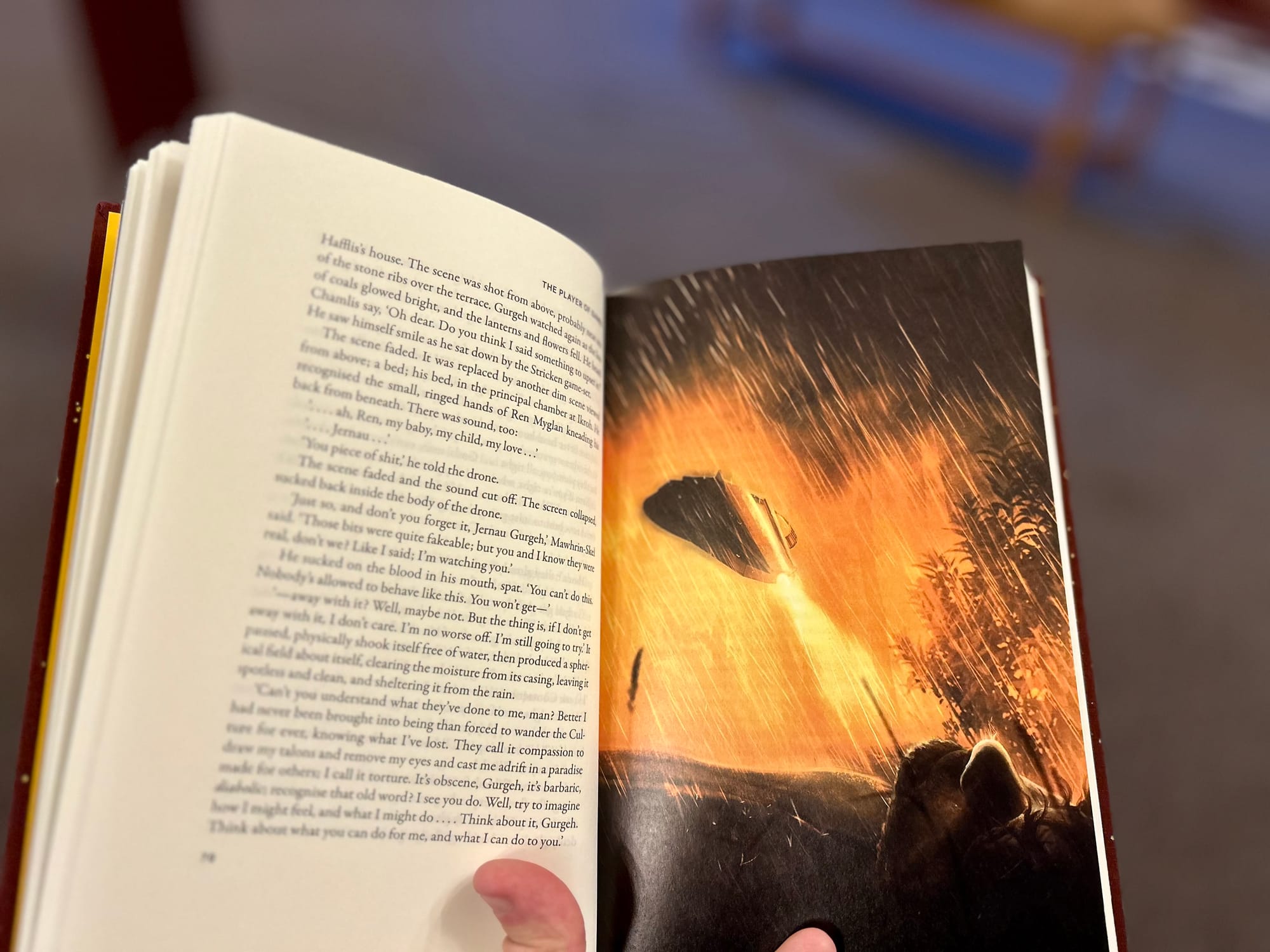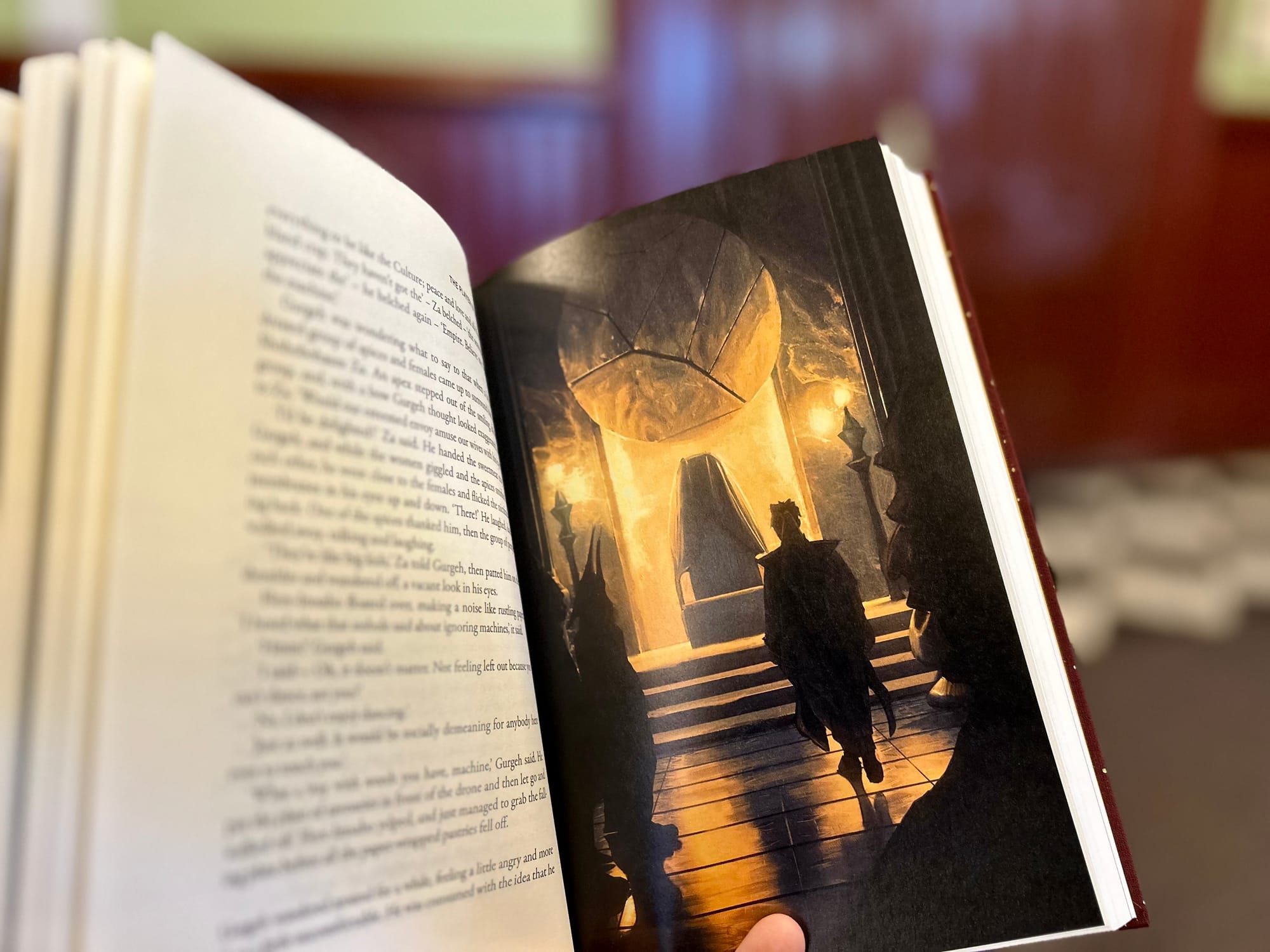Imagining The Culture
An interview with artist Dániel Taylor about his work on the Folio Society's editions of Iain M. Banks' Culture series

Years ago, I wrote a column on the history of science fiction for Kirkus Reviews: it was a fun series to write and research, because while I was a science fiction fan, it introduced me to a ton of authors that I might not have come across otherwise, and provided me with some great context for how the genre evolved, author to author.
One of the most interesting columns that I wrote was about Iain M. Banks. He wasn't an author that I'd read much from at the time, but I was fascinated by his reputation and really enjoyed the first installment of his long-running Culture series, Consider Phlebas.
When The Folio Society announced last year that it would begin publishing its own editions of The Culture series with Consider Phlebas, I was thrilled (you can see my prior coverage, reviews, and interviews related to the company here). They have an excellent track record producing some excellent volumes for readers, and it was a good excuse for me to return to the series.
Earlier this year, the company released the second installment of the series, The Player of Games, and for both editions, it brought in artist Dániel Taylor to bring the world of Banks' Culture to life. Based in Budapest, Hungary, he's been illustrating since the age of 14 and has been working as a full-time artist since 2015, with clients including Marvel, Mondo, New Scientist, Outside Magazine, and plenty more. You can follow him on Instagram here.
After reading and enjoying Consider Phlebas last year and picking up The Player of Games earlier this summer, I reached out to Taylor to chat with him about how he went about approaching the artwork for these two volumes. Here's our conversation.
This interview has been lightly edited for clarity.
To start, can you tell me a bit about your background? When did you first begin pursuing art, and who were some of the artists who inspired you to pick up the pen/pencil/paint?
It started as something of an escapism for me when I was a kid, perhaps 10-12 years old, and I was naturally attracted into just sketching things, mostly Pokémons, cartoon characters etc. This eventually led to more complex graphite pencil drawings that took me weeks to complete. I was about 15 when I got one of my friends digital drawing tablet as a gift, and this led me into digital art and illustrator as a full time job in 2015, which I still pursue to this day. Only I’ve learned a lot more skills, and softwares including 3D to help me lay out difficult environments, and its also a perfect way for me to explore different lightning scenarios during the early stages.
As for inspirations, with no particular order, were Dan Luvisi, Dave Rapoza, Agnes Cecile, Frank Frazetta, Boris Vallejo, Moebius, James Jean, Sergio Toppi and many more. Also games like World of Warcraft and Diablo played a big role when I was starting out, I wanted to be like the artist who did all the concept art for the games, thought its the coolest job ever.

Iain M. Banks' Culture series has long been a favorite of science fiction fans: when did you first read the series, and what were your impressions when you read through them?
Well, to be honest the first time I read an Iain M. Banks book is when Folio Society reached out to me about illustrating Consider Phlebas, the first of the series. I liked it very much, the world he imagined was amazing, but I personally became a big fan after finishing the 2nd book, The Player of Games, which was perfect in my opinion. I rarely get the feeling when I just can’t put a book down, but here it was certainly the case.

What is your decision process when it comes to determining what scenes to portray, and how do you go about conceptualizing them?
For the Folio Society books, when I read them, I have a notepad or something where I can note interesting parts, which I can already quite vividly imagine in my head as an illustration. I write down the page number and a few words of what peeked my interest at the time.
I only revisit the list when I’m done with the book, as there’s usually 30+ scenes written down, and need to shortlist it, keeping in mind that there should be a few pages between the 7 illustrations, so they’re not all piled up too closely. I then send the shortlist over to Folio Society and get their thoughts before moving on.
What types of things are you looking for in a text to guide you when you're envisioning a scene?
There are two types I enjoy, but for different reasons. One is where the scene is written down to every single, even minor detail, which doesn’t leave that much to your imagination. This is good in a way that you can’t “mess it up” and draw something that other readers imagined completely different.
Second version is the opposite, that sometimes you’re a lot more free in terms of how that sci-fi object, environment etc. looks, as the description can be pretty vague, but it has the issue of someone not liking your interpretation. This is also part of the reason that in The Player of Games, most of the characters’ faces are hidden, or they’re just silhouettes, so there’s a bit of room for other readers imagination.

Something that struck me with both your art in Consider Phlebas and Player of Games is how warm the scenes feel: they're blown out with yellow light. What steered you in that direction?
It was the general art direction that was requested for Consider Phlebas, along with not including any characters, so if you look closely there aren’t any at all in the environments. They were only introduced in Player of Games, which I was happy about as I reckon they make the scenes a bit more interesting.

One of my favorite illustrations between the two books is "Yay followed every move," because it feels like it has a lot of contradictions: there's motion in the background, but a quiet scene of two people at a table, with depth in the background but a closeness to the characters. What goes into a scene like that?
I think you kind of nailed the direction I was going for there, just a nice contrast of the calmness of playing a game, them talking while there’s a bit of chaos surrounding them, which may be a hint of where the story will go eventually. It’s also a scene for some reason it stuck with me, even though I read the book more than a year ago, so it’s definitely memorable.
Folio Books reprints the classics, and that often means that there's a history of prior covers, sometimes screen adaptations, or other art that's often cemented the image that readers have of the series: how do you see your relationship with the text and how you add to that? Do you feel like you need to purposefully separate yourself from those prior images, or do they have an influence?
Good question, and I try to do something different, although for covers I was definitely influenced a bit by the previous geometric, weird shaped covers as that’s something I’m more fond off, compared to having covers like the more detailed inside illustrations which are more clear in the sense of what is going on. So overall I’m influenced a bit, but I’m aware of it and try to make my own version instead.
As a bit of a followup, Banks was known for his illustrations: Orbit released a book of his art, The Culture: The Drawings last year: Did that sort of thing have any influence on you?
To be honest I haven’t seen much of that book, I’ve only noticed it in a Facebook Group when someone posted about it few months ago, but I should check it out, thanks for reminding me!
But other illustrator's work can inspire me, I’m always looking to learn, especially when I need to illustrate something that I haven’t done before and looking at how other artists do it helps. But like my previous answer, I like to mix it up with my own solutions and style.

What do you have in the works at the moment that we should look forward to next?
I can’t really talk about it unfortunately, but I have some posters coming up, like the more recent Stray poster for Mutant and we also released our own sci-fi/fantasy book almost a year ago titled Omnimorphs: Beyond the Veil.
As always, thanks for reading: I hope you've found this interesting. Are you a fan of Banks' Culture novels? What draws you to them? Let me know in the comments!
Andrew